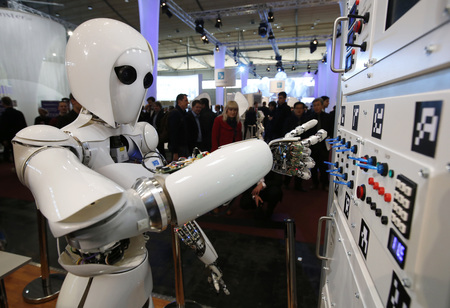
Has Robots Sustained the Industrial Revolution?


Sophia, the first-ever robot to acquire citizenship, isn’t this quite surprising. Yes! Sophia was developed by David Hanson at Hanson Robotics in Hong Kong, and it was launched on February 14, 2016. Post a year it acquired Saudi Arabia’s citizenship and got the status of being the maiden robot to get citizenship in the entire world. But, what unique feature does Sophia possess to get this eminence? Well, Sophia is a social humanoid robot which actually has cameras installed and pre-programmed with algorithms as its eyes that enables it to see, follow faces, sustain eye contact as well as recognize individuals. However, after two years of its launch in 2018, Sophia was upgraded with functional legs and the robot is capable of emoting over 60 facial expressions. Also, its speech synthesis and social skills have made it unique amongst other robots.
However, India got its first 3D-printed humanoid robot- Manav in 2014, invented by Diwakar Vaish at A-SET Robotics. This robot is just two feet tall and is equipped with onboard sound processing, where Manav could perform various activities such as walking, dancing, push up, headstands as well as play football after receiving a command in the human voice. Manav was less a human and more a human child that could learn and respond. Unlike Sophia, Manav was equipped with Binocular vision, WiFi, and Bluetooth connectivity. This robot was powered by a Lithium-polymer rechargeable battery, which could continuously operate for one hour after being fully charged.
Along with Manav, India has proudly invented seven more humanoid robots namely Mitra- developed by Bengaluru-based robotic startup Invento Robotics used at banks and malls to welcome and service customers, Robocop – a police robot developed by Hyderabad-based AI and ML startup H-Bots Robotics, Kempa – developed by a Bengaluru-based startup Sirena Technologies, RADA developed for Vistara airlines, IRA - Developed in partnership with Asimov Robotics, a start-up based in Kochi and deployed at HDFC, INDRO, Daksh - develop by Defence Research and Development Organization are the robots that have been developed in India.
Gradually, various sectors deployed robots to perform a basic activity such as greeting the customers, customer engagement, redundant tasks, and more. In the banking sector, City Union Bank had introduced the first banking robot – Lakshmi, this began as an initiative to make a transition towards a new self-service era. From being restricted to welcoming the customers, robots have evolved much more to the present day in banks, all thanks to technological advancement and rising demand for quick service. According to PwC, around 81 percent of banking CEOs are concerned about the rapid technological changes as compared to other sectors. Increased efficiency, cost-effectiveness, as well as security concern are the growing challenges of the banking sector. However, Robotic Process Automation (RPA) has turned out to be an efficient tool to counter these challenges of the banking sector and has upgraded the customer experience.
From being behind the scene and greeting customers, robots have evolved to the forefront of the banking operations and are now they are expected to reduce bank operation charges by cutting done regular staff members and decreasing physical locations. Nonetheless, not compromising on the performance, in fact, robots are set to offer increased efficiency in comparison to the regular staff at banks where accuracy and precision are crucial.
Robots have also revolutionized the healthcare sector as well. Again from just engaging the customers it has progressed to even assists doctors to perform major surgeries. Especially during the coronavirus pandemic while healthcare centers were in high demand these robots usages came as a savior in carrying out basic consultation.
At a hospital in Paris, Pepper- a caring humanoid robot was deployed to treat patients during the pandemic.
"Pepper lent a (robotic) hand during the COVID-19 pandemic, allows patients in the intensive care ward to communicate with their family, who were not allowed to visit. The robot was able to stand next to the bed of the patient and used the tablet on its chest to deliver a video conference, “said Jonathan Davenport, Senior Research Principal Analyst at Gartner.
"Though people were often on respirators, and so we're unable to speak, hospital staff noticed stress levels of both the patient and family were reduced as a result of the interactions," Jonathan said. "Pepper also reduced hospital staff risk levels by decreasing the need for physical contact with patients." (Source: zdnet.com)
With the rising use of robot usage across various industries, the robotic market is witnessing inflation thus, it has evolved rapidly and is also further expected to grow more. Global Top Robotics Market has been valued at $55.08 billion in 2018 and is estimated to touch $167.30 billion by 2026 with a growth rate being at CAGR of 14.82 percent from 2019 to 2026. According to the World Robotics report 2019, robotics is highly utilized by the automotive industry with about 30 percent installation of the total robotic system. Followed by electrical and electronics which accounts for 25 percent, metal and machinery have reported 10 percent plastic and chemical products are using five percent of robotic systems lastly, food and beverage sectors are using about three percent.